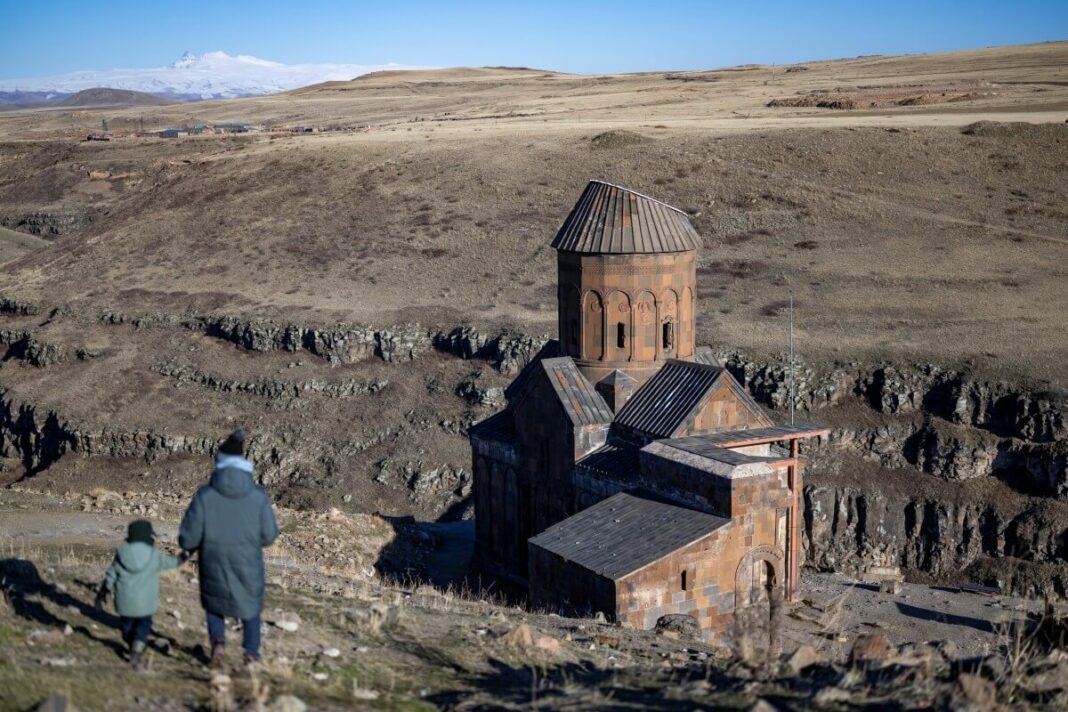“Look at this stone bridge,” said writer Vedat Akçayöz, pointing to the crumbling stumps of a 10th-century span over the Arpaçay River, which marks the closed border between Turkey and Armenia.
“The fish under the bridge, are they Turkish or Armenian?”
The spectacular ruined city of Ani stands on one of the world’s most sensitive borders, dividing two countries, daggers drawn over their painful past.
Deserted now amid snow-capped peaks, Ani was once the capital of a mediaeval Armenian kingdom before it fell to the Seljuks in 1064, the first city taken by the Turks as they swept into Anatolia. Their sultan Alparslan converted its cathedral into his “conquest mosque”.
But its sack by the Mongols and an earthquake sent Ani into terminal decline.
“This is the land conquered by our ancestors,” said Ziya Polat, governor of the nearby Turkish city of Kars. “Sultan Alparslan’s first Friday prayer, the first Turkish mosque, the first Turkish cemetery, the first Turkish bazaar, are all here,” he added.
With such symbolic importance to both sides, historians and officials hope restoring the UNESCO World Heritage Site might ease relations poisoned by the mass killing of Armenians in the Ottoman Empire during World War I, which Turkey refuses to recognize as genocide.
Akçayöz, who wrote a book on the ruins, said Ani is “humanity’s common heritage.”
“Ani was Zoroastrian, Ani was shaman, Ani was pagan, Ani was Christian, Ani was Muslim, Ani was yours, Ani was ours,” he told AFP.
Turkey and Armenia have no formal relations. But peace talks between Yerevan and Ankara’s ally Azerbaijan over the disputed territory of Nagorno-Karabakh — which Baku retook last year after a lightning war — has sparked hope that one day Turkey and Armenia could also sit down around a table.
Haunting beauty
For years Ani was off limits for tourists, with a military permit required to visit it. But local authorities are now keen to promote its haunting beauty as well as neighboring Kars, which had a large Armenian population until 1915.
With 5.5 million euros ($6 million) in funding, mostly from the European Union, they hope to draw more visitors.
Gonca Pabuççu, deputy head of the archaeological team at Ani, said restoration and conservation work has been going on for several years.
“Our aim is not only to unearth these structures, but also to preserve what we have unearthed” so tourists can visit, she said.
Akçayöz said 80 to 85 percent of the site has yet to be explored.
“Ani has an underground world as big as what is on the surface. In the caves around Ani, there are churches, mosques and places of worship. Not a lot of people know this.”
Akçayöz looks to the legacy of the Turkish-Armenian journalist Hrant Dink, who helped spark an unprecedented — if fleeting — period of dialogue and detente between the two peoples in the early 2000s.
When Dink was shot dead outside his Istanbul newspaper office in 2007 by a teenage Turkish ultranationalist, tens of thousands Turks took to the streets to express their horror, chanting, “We are all Armenians, we are all Hrant Dink.”
‘Who will cure us?’
Akçayöz pointed to a famous speech Dink gave a year before his murder saying denial and blame about the past had made Turks and Armenians both “clinically ill … Armenians with their trauma, Turks with their paranoia.”
“Who will cure us?” Dink asked. “The Armenians are the Turks’ doctor — the Turks are the Armenians’ doctor,” he said.
Akçayöz believes Dink’s vision can help end the impasse.
“There’s no other way out than peace,” he said.
A local Turkish official who wished to remain anonymous said Ani was more prone to be politicized than other archaeological sites.
“It is still a religious capital for Armenians and the first city captured in Anatolia by Turks,” he said.
Opening the sealed border would naturally increase visitor numbers, he said. “Armenians would want their grandchildren to see this site,” he said.
“We cannot build a future on past tragedies.”
© Agence France-Presse


